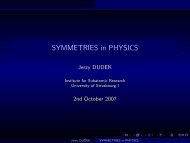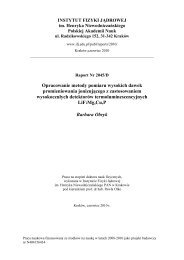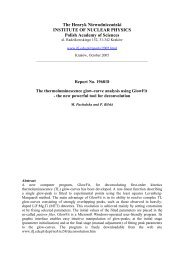Report No xxxx - Instytut Fizyki JÄ drowej PAN
Report No xxxx - Instytut Fizyki JÄ drowej PAN
Report No xxxx - Instytut Fizyki JÄ drowej PAN
Create successful ePaper yourself
Turn your PDF publications into a flip-book with our unique Google optimized e-Paper software.
35 Cl- NQR AND 1 H-NMR STUDY OF MOLECULAR DYNAMICS OF<br />
p,p′-DDA INSECTICIDE<br />
K. Makiej, A. <strong>No</strong>wacka, J. Kasprzak, R. Utrecht, J. Wąsick, B. <strong>No</strong>gaj<br />
Department of Physics, Adam Mickiewicz University, Umultowska 85, 61-614 Poznań,<br />
Poland<br />
INTRODUCTION<br />
The method of Nuclear Quadrupole Resonance (NQR) brings information not only on the<br />
electronic structure of molecules, but also on the motions of the molecules or certain atomic groups.<br />
This method along with the 1 H-NMR have been applied to study molecular dynamics of the insecticide<br />
p,p`-DDA ( 1,1-bis(p-chlorophenyl) acetic acid) [1], belonging to DDT type compounds [2]. The<br />
molecule of this compound takes the shape of a wedge with the base of phenyl rings with chlorine<br />
atoms at the para positions and the COOH group at the top.<br />
EXPERIMENTAL<br />
The compound studied p,p`-DDA was purchased at Polish Chemical Reagents – Gliwice.<br />
35 Cl-NQR measurements were performed on a lab-made pulse Fourier transform NQR spectrometer<br />
operating in the frequency range 20-40 MHz. The 35 Cl-NQR frequencies (ν Q ) and nuclear quadrupole<br />
spin-lattice relaxation times (T 1Q ) were determined in the temperature range 77K- 350.5K.<br />
Measurements of 1 H-NMR spin-lattice relaxation times (T 1 ) were made in the range 100K - 299K on a<br />
laboratory-made pulse spectrometer operating at 60 MHz.<br />
RESULTS AND DISCUSSION<br />
The NQR spectrum of p,p`-DDA shows two 35 Cl-NQR lines assigned to the two chlorine<br />
atoms in the molecule. The frequencies of these lines decrease with increasing temperature, Fig.1.<br />
35.0<br />
34.8<br />
ν Q<br />
[MHz]<br />
34.6<br />
34.4<br />
34.2<br />
34.0<br />
50 100 150 200 250 300 350 400<br />
T [K]<br />
Fig.1. Temperature dependence of 35 Cl-NQR frequency in p,p’-DDA.<br />
The difference in the slope of the ν Q (T) dependencies obtained for the two lines suggests a<br />
dynamical inequivalence of the two phenyl rings in the p,p′-DDA molecule. The values of the nuclear<br />
quadrupole spin-lattice relaxation times (T 1Q ) increase with increasing temperature (Fig.2). From the<br />
slopes of the T 1Q (T) dependencies the activation energies have been found as 3.5kJmol -1 and<br />
3.9kJmol -1 . A similar dependence has been obtained for the nuclear magnetic spin-lattice relaxation<br />
times (T 1 ). It should be noticed, that these values are very high and reach 214 s at room temperature<br />
(Fig. 3). From the slope of the T 1 (T) the activation energy has been calculated as 4 kJmol -1 .<br />
55

















